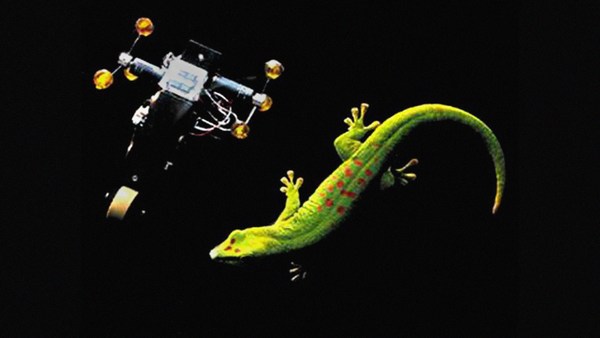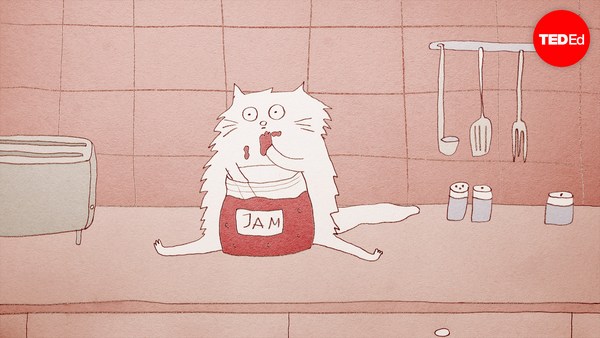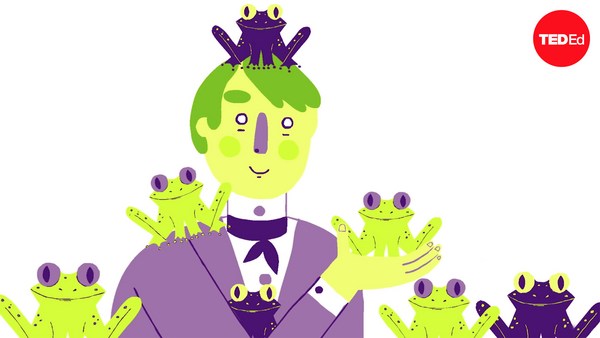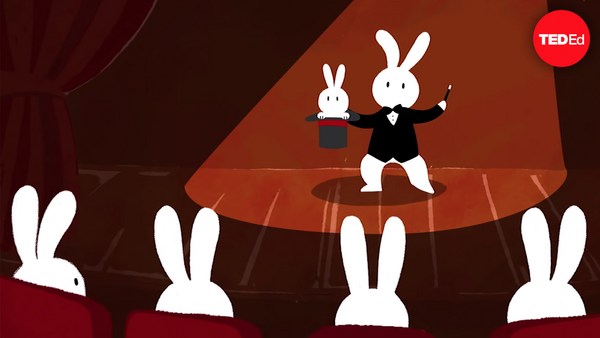A herd of wildebeests, a shoal of fish, a flock of birds. Many animals gather in large groups that are among the most wonderful spectacles in the natural world. But why do these groups form? The common answers include things like seeking safety in numbers or hunting in packs or gathering to mate or breed, and all of these explanations, while often true, make a huge assumption about animal behavior, that the animals are in control of their own actions, that they are in charge of their bodies. And that is often not the case.
This is Artemia, a brine shrimp. You probably know it better as a sea monkey. It's small, and it typically lives alone, but it can gather in these large red swarms that span for meters, and these form because of a parasite. These shrimp are infected with a tapeworm. A tapeworm is effectively a long, living gut with genitals at one end and a hooked mouth at the other. As a freelance journalist, I sympathize. (Laughter) The tapeworm drains nutrients from Artemia's body, but it also does other things. It castrates them, it changes their color from transparent to bright red, it makes them live longer, and as biologist Nicolas Rode has found, it makes them swim in groups. Why? Because the tapeworm, like many other parasites, has a complicated life cycle involving many different hosts. The shrimp are just one step on its journey. Its ultimate destination is this, the greater flamingo. Only in a flamingo can the tapeworm reproduce, so to get there, it manipulates its shrimp hosts into forming these conspicuous colored swarms that are easier for a flamingo to spot and to devour, and that is the secret of the Artemia swarm. They aren't sociable through their own volition, but because they are being controlled. It's not safety in numbers. It's actually the exact opposite. The tapeworm hijacks their brains and their bodies, turning them into vehicles for getting itself into a flamingo.
And here is another example of a parasitic manipulation. This is a suicidal cricket. This cricket swallowed the larvae of a Gordian worm, or horsehair worm. The worm grew to adult size within it, but it needs to get into water in order to mate, and it does that by releasing proteins that addle the cricket's brain, causing it to behave erratically. When the cricket nears a body of water, such as this swimming pool, it jumps in and drowns, and the worm wriggles out of its suicidal corpse. Crickets are really roomy. Who knew?
The tapeworm and the Gordian worm are not alone. They are part of an entire cavalcade of mind-controlling parasites, of fungi, viruses, and worms and insects and more that all specialize in subverting and overriding the wills of their hosts. Now, I first learned about this way of life through David Attenborough's "Trials of Life" about 20 years ago, and then later through a wonderful book called "Parasite Rex" by my friend Carl Zimmer. And I've been writing about these creatures ever since. Few topics in biology enthrall me more. It's like the parasites have subverted my own brain. Because after all, they are always compelling and they are delightfully macabre. When you write about parasites, your lexicon swells with phrases like "devoured alive" and "bursts out of its body." (Laughter)
But there's more to it than that. I'm a writer, and fellow writers in the audience will know that we love stories. Parasites invite us to resist the allure of obvious stories. Their world is one of plot twists and unexpected explanations. Why, for example, does this caterpillar start violently thrashing about when another insect gets close to it and those white cocoons that it seems to be standing guard over? Is it maybe protecting its siblings? No. This caterpillar was attacked by a parasitic wasp which laid eggs inside it. The eggs hatched and the young wasps devoured the caterpillar alive before bursting out of its body. See what I mean? Now, the caterpillar didn't die. Some of the wasps seemed to stay behind and controlled it into defending their siblings which are metamorphosing into adults within those cocoons. This caterpillar is a head-banging zombie bodyguard defending the offspring of the creature that killed it.
(Applause)
We have a lot to get through. I only have 13 minutes. (Laughter)
Now, some of you are probably just desperately clawing for some solace in the idea that these things are oddities of the natural world, that they are outliers, and that point of view is understandable, because by their nature, parasites are quite small and they spend a lot of their time inside the bodies of other things. They're easy to overlook, but that doesn't mean that they aren't important. A few years back, a man called Kevin Lafferty took a group of scientists into three Californian estuaries and they pretty much weighed and dissected and recorded everything they could find, and what they found were parasites in extreme abundance. Especially common were trematodes, tiny worms that specialize in castrating their hosts like this unfortunate snail. Now, a single trematode is tiny, microscopic, but collectively they weighed as much as all the fish in the estuaries and three to nine times more than all the birds. And remember the Gordian worm that I showed you, the cricket thing? One Japanese scientist called Takuya Sato found that in one stream, these things drive so many crickets and grasshoppers into the water that the drowned insects make up some 60 percent of the diet of local trout. Manipulation is not an oddity. It is a critical and common part of the world around us, and scientists have now found hundreds of examples of such manipulators, and more excitingly, they're starting to understand exactly how these creatures control their hosts.
And this is one of my favorite examples. This is Ampulex compressa, the emerald cockroach wasp, and it is a truth universally acknowledged that an emerald cockroach wasp in possession of some fertilized eggs must be in want of a cockroach. When she finds one, she stabs it with a stinger that is also a sense organ. This discovery came out three weeks ago. She stabs it with a stinger that is a sense organ equipped with small sensory bumps that allow her to feel the distinctive texture of a roach's brain. So like a person blindly rooting about in a bag, she finds the brain, and she injects it with venom into two very specific clusters of neurons. Israeli scientists Frederic Libersat and Ram Gal found that the venom is a very specific chemical weapon. It doesn't kill the roach, nor does it sedate it. The roach could walk away or fly or run if it chose to, but it doesn't choose to, because the venom nixes its motivation to walk, and only that. The wasp basically un-checks the escape-from-danger box in the roach's operating system, allowing her to lead her helpless victim back to her lair by its antennae like a person walking a dog. And once there, she lays an egg on it, egg hatches, devoured alive, bursts out of body, yadda yadda yadda, you know the drill. (Laughter) (Applause)
Now I would argue that, once stung, the cockroach isn't a roach anymore. It's more of an extension of the wasp, just like the cricket was an extension of the Gordian worm. These hosts won't get to survive or reproduce. They have as much control over their own fates as my car. Once the parasites get in, the hosts don't get a say.
Now humans, of course, are no stranger to manipulation. We take drugs to shift the chemistries of our brains and to change our moods, and what are arguments or advertising or big ideas if not an attempt to influence someone else's mind? But our attempts at doing this are crude and blundering compared to the fine-grained specificity of the parasites. Don Draper only wishes he was as elegant and precise as the emerald cockroach wasp. Now, I think this is part of what makes parasites so sinister and so compelling. We place such a premium on our free will and our independence that the prospect of losing those qualities to forces unseen informs many of our deepest societal fears. Orwellian dystopias and shadowy cabals and mind-controlling supervillains -- these are tropes that fill our darkest fiction, but in nature, they happen all the time.
Which leads me to an obvious and disquieting question: Are there dark, sinister parasites that are influencing our behavior without us knowing about it, besides the NSA? If there are any — (Laughter) (Applause) I've got a red dot on my forehead now, don't I? (Laughter)
If there are any, this is a good candidate for them. This is Toxoplasma gondii, or Toxo, for short, because the terrifying creature always deserves a cute nickname. Toxo infects mammals, a wide variety of mammals, but it can only sexually reproduce in a cat. And scientists like Joanne Webster have shown that if Toxo gets into a rat or a mouse, it turns the rodent into a cat-seeking missile. If the infected rat smells the delightful odor of cat piss, it runs towards the source of the smell rather than the more sensible direction of away. The cat eats the rat. Toxo gets to have sex. It's a classic tale of Eat, Prey, Love. (Laughter) (Applause)
You're very charitable, generous people. Hi, Elizabeth, I loved your talk.
How does the parasite control its host in this way? We don't really know. We know that Toxo releases an enzyme that makes dopamine, a substance involved in reward and motivation. We know it targets certain parts of a rodent's brain, including those involved in sexual arousal. But how those puzzle pieces fit together is not immediately clear. What is clear is that this thing is a single cell. This has no nervous system. It has no consciousness. It doesn't even have a body. But it's manipulating a mammal? We are mammals. We are more intelligent than a mere rat, to be sure, but our brains have the same basic structure, the same types of cells, the same chemicals running through them, and the same parasites. Estimates vary a lot, but some figures suggest that one in three people around the world have Toxo in their brains. Now typically, this doesn't lead to any overt illness. The parasite holds up in a dormant state for a long period of time. But there's some evidence that those people who are carriers score slightly differently on personality questionnaires than other people, that they have a slightly higher risk of car accidents, and there's some evidence that people with schizophrenia are more likely to be infected. Now, I think this evidence is still inconclusive, and even among Toxo researchers, opinion is divided as to whether the parasite is truly influencing our behavior. But given the widespread nature of such manipulations, it would be completely implausible for humans to be the only species that weren't similarly affected.
And I think that this capacity to constantly subvert our way of thinking about the world makes parasites amazing. They're constantly inviting us to look at the natural world sideways, and to ask if the behaviors we're seeing, whether they're simple and obvious or baffling and puzzling, are not the results of individuals acting through their own accord but because they are being bent to the control of something else. And while that idea may be disquieting, and while parasites' habits may be very grisly, I think that ability to surprise us makes them as wonderful and as charismatic as any panda or butterfly or dolphin.
At the end of "On the Origin of Species," Charles Darwin writes about the grandeur of life, and of endless forms most beautiful and most wonderful, and I like to think he could easily have been talking about a tapeworm that makes shrimp sociable or a wasp that takes cockroaches for walks.
But perhaps, that's just a parasite talking.
Thank you.
(Applause)





